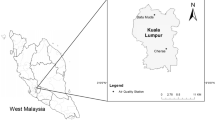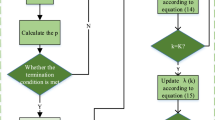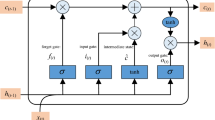Abstract
The atmospheric particulate matter (PM) with a diameter of 2.5 μm or less (PM2.5) is one of the key indicators of air pollutants. Accurate prediction of PM2.5 concentration is very important for air pollution monitoring and public health management. However, the presence of noise in PM2.5 data series is a major challenge of its accurate prediction. A novel hybrid PM2.5 concentration prediction model is proposed in this study by combining complete ensemble empirical mode decomposition (CEEMD) method, Pearson’s correlation analysis, and a deep long short-term memory (LSTM) method. CEEMD was employed to decompose historical PM2.5 concentration data to different frequencies in order to enhance the timing characteristics of data. Pearson’s correlation was used to screen the different frequency intrinsic-mode functions of decomposed data. Finally, the filtered enhancement data were inputted to a deep LSTM network with multiple hidden layers for training and prediction. The results evidenced the potential of the CEEMD-LSTM hybrid model with a prediction accuracy of approximately 80% and model convergence after 700 training epochs. The secondary screening of Pearson’s correlation test improved the model (CEEMD-Pearson) accuracy up to 87% but model convergence after 800 epochs. The hybrid model combining CEEMD-Pearson with the deep LSTM neural network showed a prediction accuracy of nearly 90% and model convergence after 650 interactions. The results provide a clear indication of higher prediction accuracy of PM2.5 with less computation time through hybridization of CEEMD-Pearson with deep LSTM models and its potential to be employed for air pollution monitoring.





Similar content being viewed by others
References
Ali M, Prasad R, Xiang Y, Yaseen ZM (2020) Complete ensemble empirical mode decomposition hybridized with random forest and kernel ridge regression model for monthly rainfall forecasts. J Hydrol 584:124647. https://doi.org/10.1016/j.jhydrol.2020.124647
Bokde N, Feijóo A, Al-Ansari N et al (2020) The hybridization of ensemble empirical mode decomposition with forecasting models: application of short-term wind speed and power modeling. Energies 13:1666
Cabaneros SM, Calautit JK, Hughes BR (2019) A review of artificial neural network models for ambient air pollution prediction. Environ Model Softw 119:285–304
Chen P-H, Lin C-J, Schölkopf B (2005) A tutorial onν-support vector machines. Appl Stoch Model Bus Ind 21:111–136. https://doi.org/10.1002/asmb.537
Cheng M, Wang B, Yang M, Ma J, Ye Z, Xie L, Zhou M, Chen W (2020) microRNAs expression in relation to particulate matter exposure: a systematic review. Environ Pollut 260:113961
Considine EM, Reid CE, Ogletree MR, Dye T (2020) Improving accuracy of air pollution exposure measurements: statistical correction of a municipal low-cost airborne particulate matter sensor network. Environ Pollut 268:115833. https://doi.org/10.1016/j.envpol.2020.115833
Dhingra S, Madda RB, Gandomi AH, Patan R, Daneshmand M (2019) Internet of Things mobile–air pollution monitoring system (IoT-Mobair). IEEE Internet Things J 6:5577–5584
Fei S (2016) A hybrid model of EMD and multiple-kernel RVR algorithm for wind speed prediction. Int J Electr Power Energy Syst 78:910–915. https://doi.org/10.1016/j.ijepes.2015.11.116
Fu M, Fan T, Ding Z, Salih SQ, Al-Ansari N, Yaseen ZM (2020) Deep learning data-intelligence model based on adjusted forecasting window scale: application in daily streamflow simulation. IEEE Access 8:32632–32651. https://doi.org/10.1109/ACCESS.2020.2974406
Geng J, Huang M-L, Li M-W, Hong W-C (2015) Hybridization of seasonal chaotic cloud simulated annealing algorithm in a SVR-based load forecasting model. Neurocomputing 151:1362–1373. https://doi.org/10.1016/j.neucom.2014.10.055
Gers FA, Schmidhuber J, Cummins F (2000) Learning to forget: continual prediction with LSTM. Neural Comput 12:2451–2471. https://doi.org/10.1162/089976600300015015
Goyal P, Kumar A (2011) Mathematical modeling of air pollutants: an application to Indian urban city. https://doi.org/10.5772/16840
Hashim BM, Al-Naseri SK, Al Maliki A et al (2021) On the investigation of COVID-19 lockdown influence on air pollution concentration: regional investigation over eighteen provinces in Iraq. Environ Sci Pollut Res 1–19. https://doi.org/10.1007/s11356-021-13812-x
Hochreiter S, Schmidhuber JJ (1997) Long short-term memory. Neural Comput 9:1–32. https://doi.org/10.1162/neco.1997.9.8.1735
Huang C-J, Kuo P-H (2018) A deep CNN-LSTM model for particulate matter (PM2. 5) forecasting in smart cities. Sensors 18:2220
Huang K, Bi J, Meng X, Geng G, Lyapustin A, Lane KJ, Gu D, Kinney PL, Liu Y (2019) Estimating daily PM2.5 concentrations in New York City at the neighborhood-scale: implications for integrating non-regulatory measurements. Sci Total Environ 697:134094. https://doi.org/10.1016/j.scitotenv.2019.134094
Khosravi K, Daggupati P, Alami MT, Awadh SM, Ghareb MI, Panahi M, Pham BT, Rezaie F, Qi C, Yaseen ZM (2019) Meteorological data mining and hybrid data-intelligence models for reference evaporation simulation: a case study in Iraq. Comput Electron Agric 167:105041
Liu X, Liu Q, Zou Y, Wang G (2018) A self-organizing LSTM-based approach to PM2.5 forecast. Cloud Computing and Security, pp 683–693
Liu H, Jin K, Duan Z (2019a) Air PM2.5 concentration multi-step forecasting using a new hybrid modeling method: comparing cases for four cities in China. Atmos Pollut Res 10:1588–1600. https://doi.org/10.1016/j.apr.2019.05.007
Liu K, Wu Q, Wang L, Wang S, Liu T, Ding D, Tang Y, Li G, Tian H, Duan L, Wang X, Fu X, Feng X, Hao J (2019b) Measure-specific effectiveness of air pollution control on China’s atmospheric mercury concentration and deposition during 2013–2017. Environ Sci Technol 53:8938–8946
Liu H, Duan Z, Chen C (2020) A hybrid multi-resolution multi-objective ensemble model and its application for forecasting of daily PM2.5 concentrations. Inf Sci 516:266–292. https://doi.org/10.1016/j.ins.2019.12.054
Loy-Benitez J, Vilela P, Li Q, Yoo C (2019) Sequential prediction of quantitative health risk assessment for the fine particulate matter in an underground facility using deep recurrent neural networks. Ecotoxicol Environ Saf 169:316–324. https://doi.org/10.1016/j.ecoenv.2018.11.024
Malhotra P, Vig L, Shroff G, Agarwal P (2015) Long short term memory networks for anomaly detection in time series. In: 23rd European Symposium on Artificial Neural Networks, Computational Intelligence and Machine Learning, ESANN 2015 - Proceedings.
Mihăiţă AS, Dupont L, Chery O, Camargo M, Cai C (2019) Evaluating air quality by combining stationary, smart mobile pollution monitoring and data-driven modelling. J Clean Prod 221:398–418
Milad A, Adwan I, Majeed SA, Yusoff NIM, al-Ansari N, Yaseen ZM (2021) Emerging technologies of deep learning models development for pavement temperature prediction. IEEE Access 9:23840–23849
Pak U, Ma J, Ryu U, Ryom K, Juhyok U, Pak K, Pak C (2020) Deep learning-based PM2.5 prediction considering the spatiotemporal correlations: a case study of Beijing, China. Sci Total Environ 699:133561. https://doi.org/10.1016/j.scitotenv.2019.07.367
Pallozzi E, Guidolotti G, Mattioni M, Calfapietra C (2020) Particulate matter concentrations and fluxes within an urban park in Naples. Environ Pollut 266:115134. https://doi.org/10.1016/j.envpol.2020.115134
Qi C, Zhou W, Lu X, Luo H, Pham BT, Yaseen ZM (2020) Particulate matter concentration from open-cut coal mines: a hybrid machine learning estimation. Environ Pollut 263:114517. https://doi.org/10.1016/j.envpol.2020.114517
Rumelhart DE, Hinton GE, Williams RJ (1986) Learning representations by back-propagating errors. Nature 323:533–536. https://doi.org/10.1038/323533a0
Soh P-W, Chang J-W, Huang J-W (2018) Adaptive deep learning-based air quality prediction model using the most relevant spatial-temporal relations. IEEE Access 6:38186–38199. https://doi.org/10.1109/access.2018.2849820
Takahashi M, Feng Z, Mikhailova TA et al (2020) Air pollution monitoring and tree and forest decline in East Asia: a review. Sci Total Environ 742:140288
Tzanis CG, Alimissis A, Philippopoulos K, Deligiorgi D (2019) Applying linear and nonlinear models for the estimation of particulate matter variability. Environ Pollut 246:89–98. https://doi.org/10.1016/j.envpol.2018.11.080
Wang P, Zhang H, Qin Z, Zhang G (2017) A novel hybrid-Garch model based on ARIMA and SVM for PM 2.5 concentrations forecasting. Atmos Pollut Res 8:850–860. https://doi.org/10.1016/j.apr.2017.01.003
Wen C, Liu S, Yao X, Peng L, Li X, Hu Y, Chi T (2019) A novel spatiotemporal convolutional long short-term neural network for air pollution prediction. Environment Sci Total Environ 654:1091–1099
Yaseen ZM (2021) An insight into machine learning models era in simulating soil, water bodies and adsorption heavy metals: review, challenges and solutions. Chemosphere 277:130126
Yaseen ZM, Sulaiman SO, Deo RC, Chau K-W (2018) An enhanced extreme learning machine model for river flow forecasting: state-of-the-art, practical applications in water resource engineering area and future research direction. J Hydrol 569:387–408. https://doi.org/10.1016/j.jhydrol.2018.11.069
Yeh J-R, Shieh J-S, Huang NE (2010) Complementary ensemble empirical mode decomposition: a novel noise enhanced data analysis method. Adv Adapt Data Anal 02:135–156. https://doi.org/10.1142/s1793536910000422
Yi X, Zhang J, Wang Z et al (2018) Deep distributed fusion network for air quality prediction. In: Proceedings of the 24th ACM SIGKDD. International Conference on Knowledge Discovery & Data Mining:965–973
Yuchi W, Gombojav E, Boldbaatar B, Galsuren J, Enkhmaa S, Beejin B, Naidan G, Ochir C, Legtseg B, Byambaa T, Barn P, Henderson SB, Janes CR, Lanphear BP, McCandless LC, Takaro TK, Venners SA, Webster GM, Allen RW (2019) Evaluation of random forest regression and multiple linear regression for predicting indoor fine particulate matter concentrations in a highly polluted city. Environ Pollut 245:746–753. https://doi.org/10.1016/j.envpol.2018.11.034
Zhou Y, Chang FJ, Chang LC, Kao IF, Wang YS, Kang CC (2019) Multi-output support vector machine for regional multi-step-ahead PM2.5 forecasting. Sci Total Environ 651:230–240. https://doi.org/10.1016/j.scitotenv.2018.09.111
Acknowledgements
We would like to thank Editage for English language editing.
Availability of data and materials
Data were obtained from the online website: https://www.aqistudy.cn/.
Funding
This work was supported by the National Natural Science Foundation of China (grant number 61973275).
Author information
Authors and Affiliations
Contributions
MF: data curation; formal analysis; methodology; investigation. CL: visualization; writing—original draft, review & editing draft preparation; resources; software. TF: visualization; writing—original draft, review & editing draft preparation. RP: formal analysis, project administration; writing—review & editing. DM: data curation; formal analysis; methodology; investigation; visualization; writing—original draft, review & editing draft preparation. OD: writing—original draft, review & editing draft preparation. DL: supervision, conceptualization; project administration; writing—review & editing. SS: validation, manuscript revision, analysis, investigation, and writing up. ZMY: supervision, conceptualization; project administration; writing—review & editing.
Corresponding author
Ethics declarations
Ethics approval
The manuscript is conducted within the ethical manner advised by the Environmental Science and Pollution Research.
Consent to participate
Not applicable.
Consent for publication
The research is scientifically consented to be published.
Conflict of interest
The authors declare no competing interests.
Additional information
Responsible Editor: Marcus Schulz
Publisher’s note
Springer Nature remains neutral with regard to jurisdictional claims in published maps and institutional affiliations.
Rights and permissions
About this article
Cite this article
Fu, ., Le, C., Fan, . et al. Integration of complete ensemble empirical mode decomposition with deep long short-term memory model for particulate matter concentration prediction. Environ Sci Pollut Res 28, 64818–64829 (2021). https://doi.org/10.1007/s11356-021-15574-y
Received:
Accepted:
Published:
Issue Date:
DOI: https://doi.org/10.1007/s11356-021-15574-y




